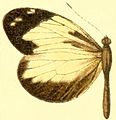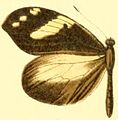| Dismorphia crisia | |
|---|---|
 | |
| Male D. c. crisia | |
 | |
| Female | |
| Scientific classification | |
| Domain: | Eukaryota |
| Kingdom: | Animalia |
| Phylum: | Arthropoda |
| Class: | Insecta |
| Order: | Lepidoptera |
| Family: | Pieridae |
| Genus: | Dismorphia |
| Species: | D. crisia |
| Binomial name | |
| Dismorphia crisia | |
| Synonyms | |
| |
Dismorphia crisia, the crisia mimic white or cloud forest mimic-white, is a butterfly in the family Pieridae. The species was first described by Dru Drury in 1782. It is found from northern Central America to Bolivia and the Amazon basin. [2]
Contents
The wingspan is 48–53 mm (1.9–2.1 in) for males and about 57 mm (2.2 in) for females. [2] It is a very variable species.
The larvae feed on Inga and Pithecellobium species. [1]



